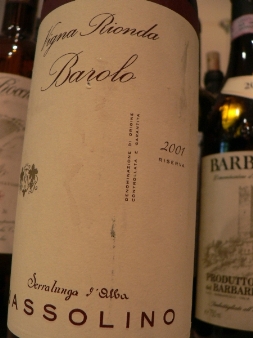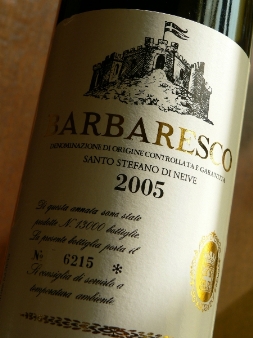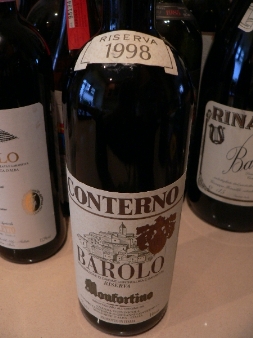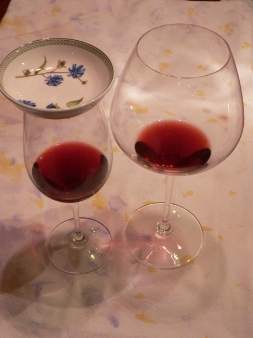Views: 64
上一篇介紹的醒酒法看似複雜,其實道理很簡單,目的是用緩慢的方法加氧氣來促進酒的成熟﹕最慢也是最自然的方法是原瓶呼吸;稍快一點的方法是把部分酒換到另一小瓶子(375mm 或 187mm),同時讓原瓶的酒有更多氧氣供應。等到正式下杯的時候,如果發現原瓶內的酒仍然不夠開放,便可以把換瓶的部分倒回原瓶,讓更多氧氣的酒幫助較少氧氣的酒。
這個方法提供了從低到高三級的氧化速度,很有彈性,而且是漸進的,比一下子把酒倒進大的 Decanter 安全(下文還會說明用 Decanter 的另一危險)。我最近上網找資料,意外的發現原來 Meo-Camuzet 也曾經教人用一個類似的方法來處理 Burgundy(見﹕http://www.burgundy-report.com/forum/topic.php?id=192 一位名叫 Joachim 的評論)。
至于用猛力搖動酒瓶,做法不太實際,我提起它是借以說明酒的成熟也可以在缺氧的情況下進行的。但有一位網友指出原來澳大利亞的 Mollydooker 酒莊曾推薦用這種方法醒酒(見﹕http://www.mollydookerwines.com/assets/client/File/Mollydooker%20Shake_Final.pdf ),他自己試用過以後卻發現得不償失。我懷疑如果酒在搖動以後讓他休整一兩個星期會有比較好的效果。
以上講的是醒酒的方法,但當發現酒快要入睡的時候,我們卻需要反其道而行﹕想辦法減慢而不是加快酒的成熟進程。
比較複雜的酒在他們春夏之交有時候是會入睡的,我以前遇過Bordeaux 和Burgundy 的例子,但我的經驗還是以Barolo和 Barbaresco 居多,所以我想就這方面舉例子談一下。
這些嬰兒睡姿不一,有些酒開瓶後幾乎一下杯便入睡,有些酒會等你喝了大半杯,又有一些酒第一天表現完全正常,但放到第二天或甚至五六天後才開始入睡。

這瓶2001 Massolino Barolo Vigna Rionda Riserva 約在 2004 年底入瓶,我在 2009 年 9 月也就是入瓶後約 5 年開這瓶酒,第一天香與味都精彩萬分,剩下的半瓶第二天再試,發現香氣跑掉了,早上用力搖酒杯時還有輕微的花香味,但等到晚上正式喝的時候,卻只有酸酸的氣味和類似茶葉的口感,這個 8 歲的小孩睡著了!第三天的情況差不多,之後我們外遊,到第 13 天回來時發現酒已醒來,有很濃烈的酒體和非常豐滿的味道,可惜有氧化的氣味。
這個 8 歲小孩第 2 天入睡,第 4-13 天之間睡醒。


這瓶 2005 Giacosa Barbaresco Santo Stefano 估計在 2007 年底入瓶,我在 2009 年 12 月也就是入瓶後兩年開這瓶酒,第一天下杯後香與味都正常,但大概過了半個小時,我突然發現香氣完全消失了,味道變得淡淡的。第二天的酒好像半睡半醒,要用力搖杯子才有比較充足的香與味。
這個 4 歲小孩第 1 天入睡,第2 天慢慢蘇醒。
我開始研究這個問題。
以前讀過 Antonio Galloni 的酒評,他提過有些酒會 “sleep in the glass”,又說快要睡覺的酒切勿 decant,因為這時候供應更多氧氣是會令酒更快入睡的。這次終于讓我有機會親歷“sleep in the glass” 是什麼一回事,但究竟為什麼會加氧才入睡呢?我幾個月前才找到一個讓我可以明白的解釋,來源是 erobertparker.com 的論壇。
論題是“Why do wines shut down?” (有訂閱erobertparker.com 的可以查閱﹕http://dat.erobertparker.com/bboard/showthread.php?t=203283)
有一位名叫G. Tatar的看法很有見地﹕
One of the best explanations I’ve heard. I always wondered about the “dumb phase” and if and/or when it starts and ends. Clearly it depends on the specific wine and vintage in question. But I don’t think it’s explained well.
If and when it happens, it seems to be a result of many different factors. There is almost always some slow oxidation taking place as oxygen combines with any number of compounds. There is polymerization of tannins. The anthocyanins break apart and combine with oxygen or even with tannins, so the color shifts. There is also polymerization of various phenols from the grapes and also from the oak, which is part of how the oak “integrates”. Depending on how much bacteria is around, it may start to reproduce and you can get a shift in aroma to a more sour, pungent smell. There are various reactions with the sulfur added to the wine and with the sulfur compounds already in the wine. There is breakdown of the complex sugars into simpler, more volatile sugar compounds. Some of the processes can take place in an oxygen-poor environment and will smell different than had they taken place in an oxygen-rich environment. A lot of the fruit aromas are caused by the volatile compounds produced by yeasts and/or their reactions with alcohol. With time, some of these change as well. There are remnants of the yeast that still decompose.
The pH of the wine has an effect on the rate and types of reactions. The temperature has a lot to do with the rate and type of reaction. And sedimentation also does, so shaking the bottle and redistributing the contents and the air will affect it. The Italian Journal of Food Science published a study on Amarone chemistry, for example, and stated ” . . . pH, total polyphenols and total anthocyanins, gallic acid, catechin, p-coumaric acid, t-resveratrol and cyanidin-3-O-glucoside content were significantly related to wine ageing.” So the advice above related to “high acid/ firmer tannin/cooler vintage” is quite logical.
And there are many more reactions and there is a lot more interplay. Most importantly, these do not take place at the same rate. So at any given time, there is a particular combination of things happening. The loss of the initial fruit seems to be the most obvious initially, because the esters and compounds that produce those aromas are in part a result of the yeast action and there are more produced than equilibrium warrants, so they tend to reform into other compounds. In part, that may be the “dumb” phase, because you have a moment without a lot of fruit and yet without the other reactions having taken place.
But it isn’t going to occur in every case and it’s impossible to predict. So sampling is the key. Try the wine at various points and when it hits the sweet spot, drink it.
打個比較易懂的比喻﹕一瓶酒的成熟過程,好比一齣分開很多幕上演的戲劇或話劇,在兩幕之間會關燈換場景,所以我們如果在換場的時候走進戲院,眼前便會漆黑一片,這便是「睡覺」的錯覺。
所以如果你在一幕將結束的時候進場,又(用 Decanter)命令演員加快表演,這一幕便會馬上演完,隨即要換場,此所以快要睡覺的酒切忌 decanting。
上個月我很偶然的正好踫上這一刻。


我與這瓶 1998 Giacomo Conterno 的 Monfortino 是第二次踫頭。一年半以前,我大膽開過一瓶,前後試了 30 天,原來想驗證 Barolo 是否放久一點更好喝,結果經歷了這瓶酒的春夏秋三季(見前文﹕不可思議的 Monfortino (上篇))。有趣的是,上次這瓶 11 歲半的小孩第一天很精彩,到第 5 天第二次品試時已睡著,第 11 天氣味氧化了,是半睡半醒的狀態,到第 14 天才真正醒來,所以皇上一睡便 10 天。
過了一年半,他已經是個 13 歲的小孩(離入瓶約 6 年)。
這次我原來想好好享受一瓶好酒,完全沒有做試驗的想法。
早上開瓶後,我馬上倒了一小杯,並用醬油碟子蓋著。我開老酒都有這個習慣,目的是試試酒的持久能力,這次慣性的也這樣做了。
一個小時後,我用 Burgundy 杯子倒了一小杯,發現有極端強烈的香氣蜂擁而出,我名之曰惡香、惡臭,大體是很礦物的、藥材似的,很典型的 Monfortino。大概過了 15 分鐘,香氣慢慢跑掉了,口感是酸一陣、甜一陣,很活躍但像頭髮蓬鬆似的令人摸不著頭腦,這個狀態大概維持了半個小時。
又過了 15 分鐘,好像有點微弱的花香,但很快又跑掉了。
下杯後一個小時,一切歸于沉寂,孩子乖乖的熟睡了。
我這時覺得很無奈。我與 1998 Monfortino 難道真的無緣?

我忽然想起我開瓶後倒出然後用小碟子蓋著的一小杯酒。拿來一嗅,發現惡香依然,口感豐滿!我蓋回碟子,之後幾個小時又試了好幾次,他的惡香和濃味仍然維持。
我想起我幾個月前看過關於酒的入睡如話劇換場的論述,便馬上決定我們晚上喝這瓶酒的最好方法,是學我爸爸以前在茶樓喝普洱那樣,用個有蓋的「焗盅」(廣東人叫法),要喝茶時才打開「焗盅」的蓋子倒茶進杯子。
我們晚上用了兩個小酒杯,每次要喝的時候從酒瓶倒出一小杯,喝罷蓋上小碟子,大概分兩三口喝完小杯的酒才再倒另一杯。
酒既香且濃,雖然有濃得化不開的感覺,但總比睡著的酒好喝。
這時我又做了個試驗,倒了一點酒進一個 Burgundy 杯子,用正常的方法來輕搖,但見香氣在兩分鐘後開始明顯消退,下杯後 5 分鐘便消失得無影無蹤!
仍然用上面演戲的例子,這晚我們央求Monfortino 放慢動作表演,難得他肯在欲睡卻不忍心睡的狀態下陪了我們一整個晚上。
我們留了半瓶沒有喝,想看看他要過幾天才睡醒。這次我把酒瓶放在 Eurocave 的SOWINE 醒酒器,並用抽真空的方法處理,希望他不會像上次那麼快氧化。
結果酒到第 5 天沒有醒,到第 11 天也沒有醒,直到第 14 天終于醒了。這時有很輕微的像鹹酸菜似的氧化氣味,但味道豐富,酸度也充足。
到第 15 天,我停止了抽真空。
酒的味道在第18-25 天達到最高的勁度(intensity),之後徐徐下降,但保持很平衡的酒體,感覺有點秋意,而且氣味更氧化了,但氧化的程度比一年前的那瓶輕很多。
到第 29 天,我們把餘下的小量酒與來訪的好友分享了。
不可思議的 Monfortino 與我還是挺有緣的,這次他教懂我如何處理入睡的酒。
如果再讓我踫到這個機會,我會在他剛醒的一天(第 14 天)用上一篇介紹的醒酒法讓他使出渾身解數,這樣或許可以讓酒更快更好喝,也避免了酒精的進一步氧化。
今天我可以肯定的說﹕Barolo 的四季都可愛至極。
Thank you, Barolo!



後記
回想我對Barolo 的探索,是從橫的方向開始的。我先從每個主要產區找來領先的酒莊,一瓶一瓶的慢慢品試。然後我探究不同年份的特性,如 1971、1989、1996、1997、2000 等。但最重要的一關是處理新酒的方法,因為這是一把鑰匙,有了它才可以比較容易的打開橫橫直直的門,這個試驗斷斷續續進行了兩三年了,到今天好像可以對零零碎碎的發現作一個小結。
有網友說過程比結果重要,但對我來說,離開 emozione 便本來無一物。
寫這幾篇文章還有另外一些原因。
我有幾位要好的酒友是行業中人,我常鼓勵他們為意大利酒多做一點推介工作,但是除了介紹他們喝充滿emozione 的酒以外,我唯一可以做到的便是寫一點這樣的文字,希望對他們有些幫助吧。
此外,常有對Barolo 剛發生興趣的網友問我處理Barolo 的各種具體問題,我希望這幾篇文章對他們有參考價值。
All in the name of emozione.
全文完
获益良多,Grazie Mile!
[版主回覆02/08/2012 23:07:30]Per emozione!
心兄,
有幸拜讀大作,獲益良多。小弟身體抱恙,兩個多星期來滴酒未沾,但心兄一文令我有一衝動去把酒櫃內之 Rionda (Giacosa 及 Massolino) 來個 vertical tasting…
Keep it up! Cheers from New York.
[版主回覆02/18/2012 18:45:52]I have tried Giacosa's 1993 Rionda. My bottle shows it's feminine and supple on day 1, but stale and fruit is gone on day 2. Hope you have a better bottle, but seems safe to drink now!
[版主回覆02/11/2012 07:59:13]Yes I certainly remember the Massolino wine dinner, and I envy you. His Rionda is a late developer, probably among the latest of any wine; has tons of character. His old vintages are so hard to find. I had his '89 Rionda (but not a Riserva!) last week, but it was infected with a soya sauce like nose, not a well kept bottle. I got only Roagna's 2005, and will be tasting later this month, together with Pira Luigi and Oddero. Great is Rionda, and great is Barolo!!! Thanks for sharing.
[Brian回覆02/11/2012 01:45:16]I was lucky enough to get a hold of a bottle of Giacosa's last vintage (1993) Rionda for a very reasonable price. I just don't think I can afford any of his red label older vintage wines at this point…lucky you.
On the other hand, I have accumulated bottles of '95, '97, '98 and '00 Massolino Rionda. One of the best wines I've ever had was a 1989 Rionda Riserva from Massolino's own cellar (remember that winemaker dinner I told you about? 8 hours of slow-O did the trick there).
That was an awe-inspiring experience even with my very limited exposure to Barolo. You are absolutely right, it's rustic. However, with age, the rough edges got rounded off to a more elegant, sophisticate stage. I can't describe the flavor / nose now, but I still clearly remember the sensation about this wine up to today. It's reminded me of Luciano Pavarotti's performance of Nessun Dorma in his 50’s. I just had to ask Franco to sign that bottle for me. THIS 1989 is the unicorn I have to chase after…
On the other hand, I also brought a case of Roagna 2004 Rionda. For its price, I think Luca Roagna is doing a very respectable job with his Barolo/Barbaresco. Still very young at this stage but I did enjoy his 1996 Barbaresco a lot.
Cheers!
[版主回覆02/10/2012 11:16:58]希望早日康復,早沾美酒!
[版主回覆02/10/2012 11:16:01]Wow!您的 Giacosa 是哪個年份?以前好像跟您交流過 Giacosa 的 Rionda 是來自一位名叫 Canale 的酒農的,我最近竟然找到他釀的 1974 和 1978,還沒試!又您大概知道 Canale 最近去世了,他的田分了給幾個親戚,包括 Giovanni Rosso 和一個叫 Guido Porro 的。 Massolino 的風格似乎較粗獷,絕對沒有 Giacosa 的仙氣。
Hi 心兄,
Thank you for your article. From your experience, are traditional Barolo like B. Giacosa, G. Conterno will have the "deep sleep" problem if access when young? It sounds to me the modern Barolo like Sandrone, etc. does not have such problem. What is your experience?
[版主回覆02/16/2012 20:59:04]I don't have a definitive answer as I drink far more "traditional" Barolos than "modernist". If I were to venture a guess, I would say the traditionalists are more unpredictable, perhaps because they were less accustomed to oxygen during their incubation. On the other hand, I did experience shutdown with Gaja, Bordeaux and Burgundy, so I cannot say barriques necessarily excuse them from such "troubles". In conclusion, it would be fair to guess that barrique treatment smoothes out rather than stamps out irregularities during the early development stages of a complex wine. I don't know, I'm just guessing.